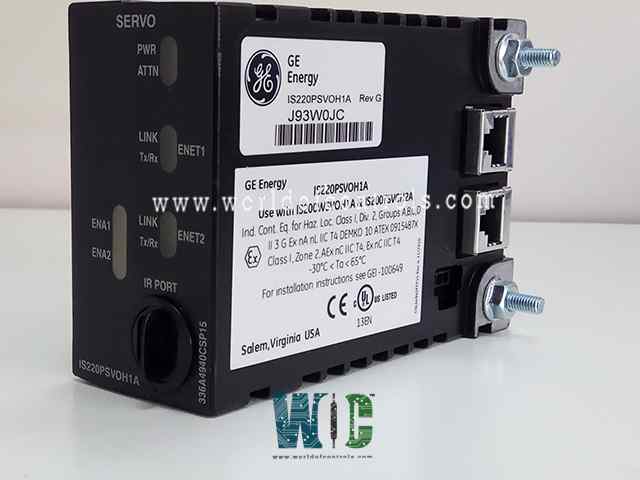
World Of Controls understands the criticality of your requirement and works towards reducing the lead time as much as possible.
IS220PSVOH1A, REV E - Servo Control I/O Module is available in stock which ships the same day.
IS220PSVOH1A, REV E - Servo Control I/O Module comes in UNUSED as well as REBUILT condition.
To avail our best deals for IS220PSVOH1A, REV E - Servo Control I/O Module, contact us and we will get back to you within 24 hours.
SPECIFICATIONS:
Part Number: IS220PSVOH1A, REV E
Manufacturer: General Electric
Product Type: Servo Control I/O Module
Function: I/O Module
Series: Mark VIe
Number of outputs: 2
Power supply voltage Nominal: 28 V dc
Pulse rate accuracy: 0.05%
Magnetic PR pickup signal Generates: 150 V
Operating temperature: -30 to +65°C
Size: 8.26 cm high x 4.19 cm
Input Filter: Hardware Filter, 4 ms
Technology: Surface-mount
Availability: In Stock
Weight: 0.8kg
Repair: 3-7 Day
Country of Origin: USA
Manual: GEH-6721D
FUNCTIONAL DESCRIPTION:
IS220PSVOH1A, REV E is a Servo Control I/O Module manufactured and designed by General Electric as part of the Mark VIe Series used in GE Distributed Turbine Control Systems. The PSVO I/O pack interfaces one or two I/O Ethernet networks with a TSVO servo terminal board. It includes a processor board common to all Mark VIe distributed I/O packs and a dedicated I/O board for servo functions. Working alongside the WSVO servo driver module, it manages two servo valve position loops with selectable output currents ranging from 10-120 mA DC. Additionally, it provides LVDT excitation, supports eight LVDT feedback inputs, and processes two pulse rate inputs from fuel flow meters. The pack receives input via dual RJ45 Ethernet connectors and is powered by a 28 V DC supply from the terminal board. Output is transmitted through a DC-62 pin connector that links directly to the terminal board connector. Visual diagnostics are indicated by LEDs, and local diagnostics are accessible through an infrared port for serial communication.
COMPATIBILITY:
PSVOH1A is compatible with the Servo Terminal Board TSVCH1A, but not the DIN-rail mounted DSVO board or the TSVOH1B. The following table gives details of the compatibility:
INSTALLATION:
OPERATIONS:
The processor board connects to an acquisition board tailored to the I/O pack function. When input power is applied, the soft-start circuit gradually increases the voltage on the processor board. Local power supplies are activated, and the processor reset is released. The processor runs self-test routines and loads application code from flash memory specific to the I/O pack type. It then verifies board ID information to ensure proper alignment between the application code, acquisition board, and terminal board. If the match is correct, the processor requests a network address using DHCP and the terminal board's unique identification. After Ethernet initialization, the processor programs the on-board logic, executes the application and allows the acquisition board to begin operation.
POWER MANAGEMENT:
The PSVO includes power management in the 28 V input circuit. The management function provides a soft start to control current inrush during power application. After applying power, the circuit provides a fast current limit function to prevent a pack or terminal board failure from propagating back onto the 28 V power system. When power is present and working properly, the green PWR indicator will light. If the current limit function operates, the indicator will be out until the problem is cleared.
WOC has the largest stock of GE Distributed Control System Replacement Parts. We can also supply unused and rebuilt backed-up with a warranty. Our team of experts is available round the clock to support your OEM needs. Our team of experts at WOC is happy to assist you with any of your automation requirements. For pricing and availability on any parts and repairs, kindly get in touch with our team by phone or email.
What is the maximum number of I/O points supported by a typical Servo Control I/O Module?
The number of I/O points that a Servo Control I/O Module can support varies based on the module's design and purpose. Standard modules generally support anywhere from 4 to 64 I/O points, which can be expanded based on system requirements. For more complex systems, modules designed for high-density control can support up to 128 or more I/O points, making them suitable for systems that require controlling multiple axes or motors simultaneously.
What voltage ranges do Servo Control I/O Modules support?
Servo Control I/O Modules are designed to work with a wide range of voltage levels to accommodate various servo drives and control systems. The input voltage typically falls within a range of 24V DC to 48V DC, which is standard for industrial automation systems.
What is the significance of pulse width modulation (PWM) in Servo Control I/O Modules?
Pulse Width Modulation (PWM) plays a crucial role in Servo Control I/O Modules, as it is commonly used to control motor speed and position. PWM works by varying the width of the pulses sent to the motor, which in turn adjusts the power delivered. By changing the duty cycle of the pulses, PWM allows for fine control over motor behavior, enabling smooth adjustments to parameters like speed and torque.
What types of feedback signals are supported by Servo Control I/O Modules?
Feedback signals are essential in Servo Control I/O Modules to monitor and adjust motor performance. Common types of feedback include incremental encoder feedback, which measures the position of the servo motor by counting pulses, offering high-speed and precise position control.